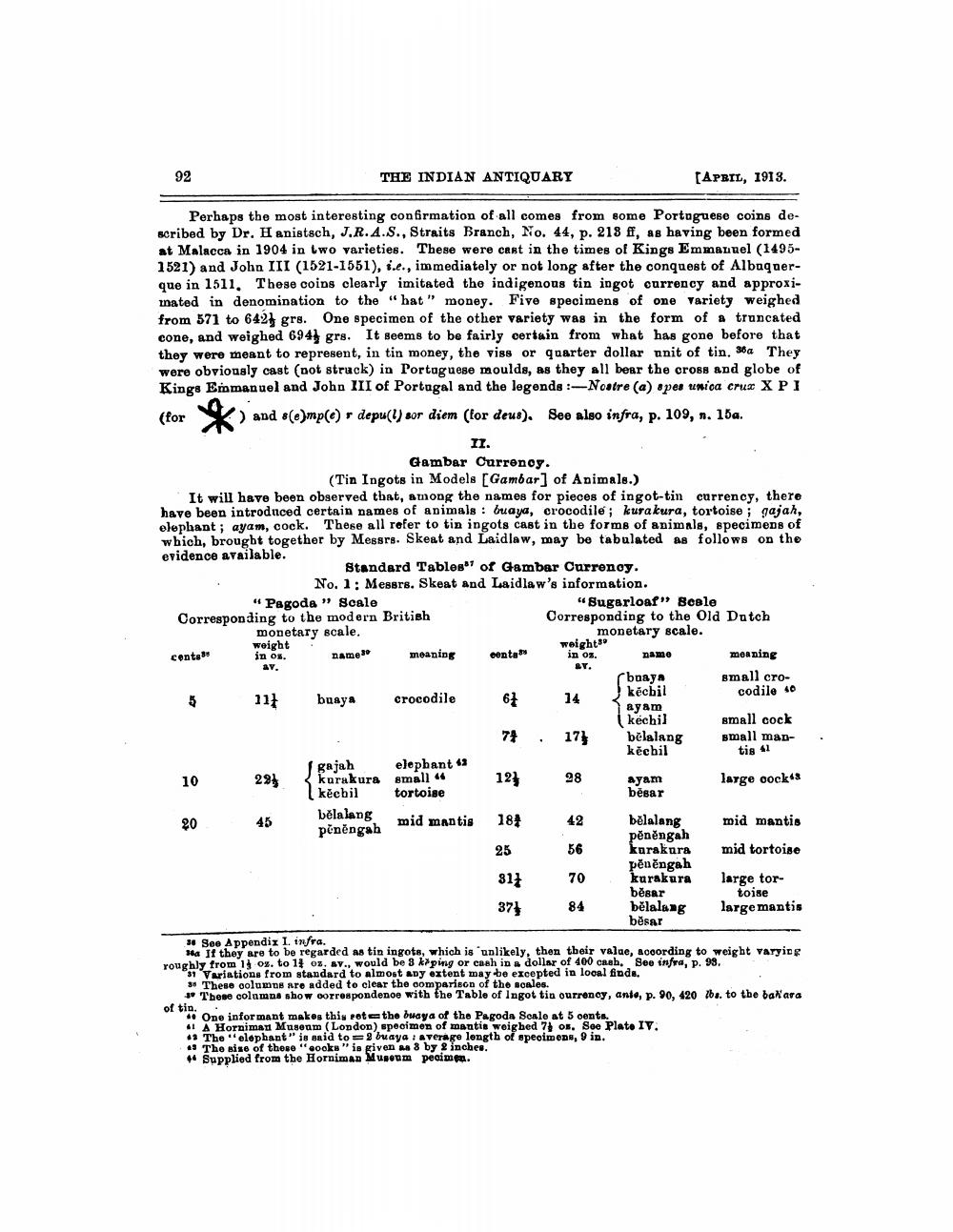________________
92
Perhaps the most interesting confirmation of all comes from some Portuguese coins described by Dr. Hanistsch, J.R.A.S., Straits Branch, No. 44, p. 218 ff, as having been formed at Malacca in 1904 in two varieties. These were cast in the times of Kings Emmanuel (14951521) and John III (1521-1551), s.e., immediately or not long after the conquest of Albuquerque in 1511. These coins clearly imitated the indigenous tin ingot currency and approximated in denomination to the "hat" money. Five specimens of one variety weighed from 571 to 642 grs. One specimen of the other variety was in the form of a truncated cone, and weighed 694 grs. It seems to be fairly certain from what has gone before that they were meant to represent, in tin money, the viss or quarter dollar unit of tin, 36a They were obviously cast (not struck) in Portuguese moulds, as they all bear the cross and globe of Kings Emmanuel and John III of Portugal and the legends :-Nostre (a) spes unica crux X PI ') and s(e)mp(e) r depu(l) sor diem (for deus). See also infra, p. 109, n. 15a.
(for
II.
Gambar Currency.
(Tin Ingots in Models [Gambar] of Animals.)
It will have been observed that, among the names for pieces of ingot-tin currency, there have been introduced certain names of animals: buaya, crocodile; kurakura, tortoise; gajah, elephant; ayam, cock. These all refer to tin ingots cast in the forms of animals, specimens of which, brought together by Messrs. Skeat and Laidlaw, may be tabulated as follows on the evidence available.
Standard Tables" of Gambar Currency. No. 1: Messrs. Skeat and Laidlaw's information. "Pagoda" Scale Corresponding to the modern British
monetary scale. weight
in os.
name30
av.
cents
5
10
20
111
29
THE INDIAN ANTIQUARY
45
buaya
gajah kurakura kěchil
bělalang pěněngah
meaning
crocodile
elephant 43 small 44 tortoise
mid mantis
centa
181
61
74 17
121
25
311
37
"Sugarloaf" Scale Corresponding to the Old Dutch monetary scale.
weights in oz. &T.
14
28
42
56
70
84
name
buaya
kechil
ayam
kechil
bělalang kěchil
ayam
besar
[APRIL, 1913.
bělalang pěněngah karakura pěněngah kurakura
besar bělalang besar
of tin.
One informant makes this set the buaya of the Pagoda Scale at 5 cents.
41 A Horniman Museum (London) specimen of mantis weighed 7 os. See Plate IV.
2 The elephant" is said to = 2 buaya: average length of specimens, 9 in. The size of these "sooks" is given as 3 by 2 inches.
Supplied from the Horniman Museum pecimen.
meaning small crocodile 40
small cock small mantis 41
large cock's
mid mantis
mid tortoise
large tor
toise large mantis
38 See Appendix I. infra.
sa If they are to be regarded as tin ingots, which is unlikely, then their value, according to weight varying roughly from 1 oz. to 13 oz. av., would be 3 kaping or cash in a dollar of 400 cash. See infra, p. 98.
31 Variations from standard to almost any extent may be excepted in local finds.
3 These columns are added to clear the comparison of the scales.
These columns show correspondence with the Table of Ingot tin currency, ante, p. 90, 420 lbs. to the banara




